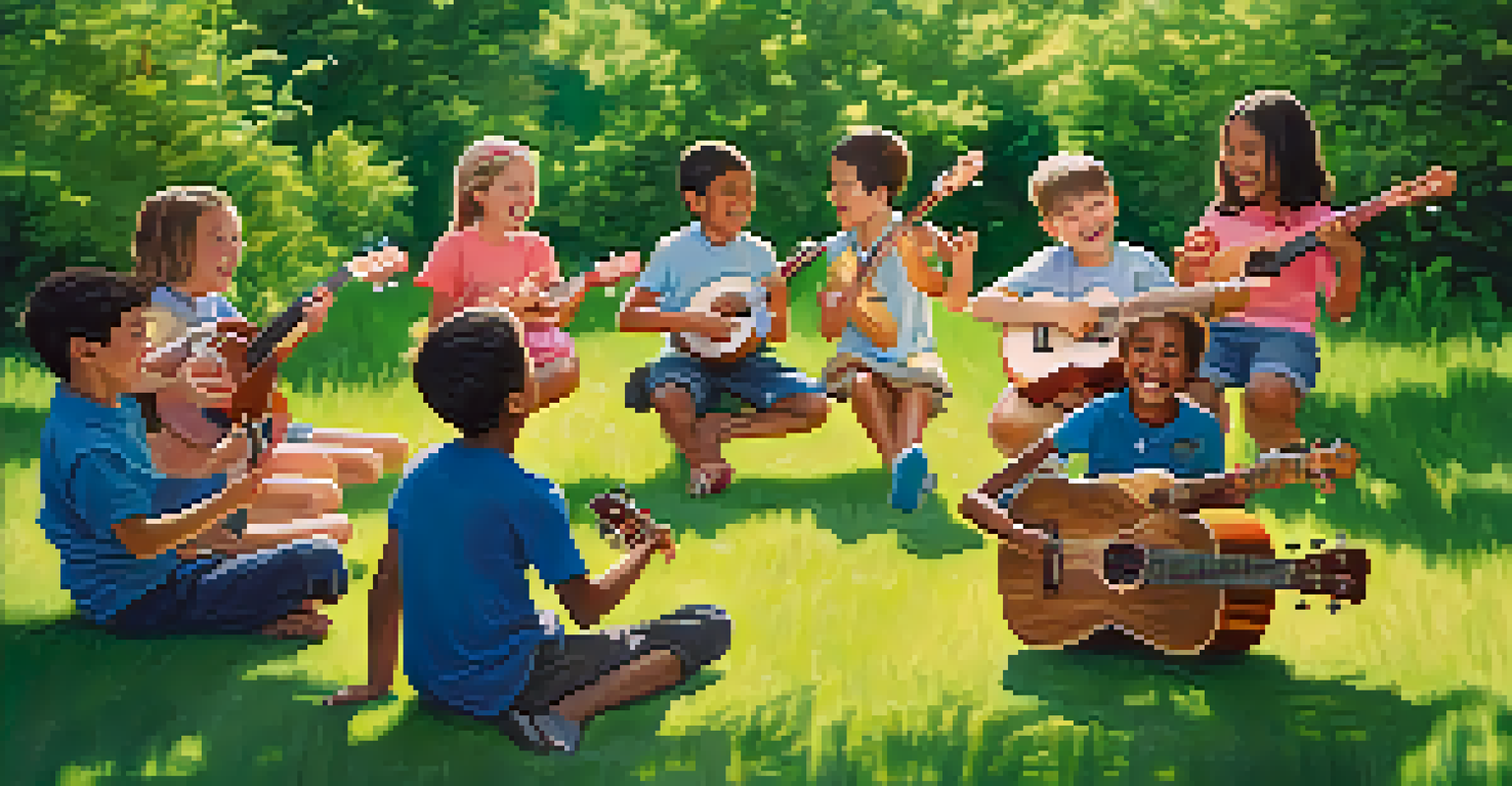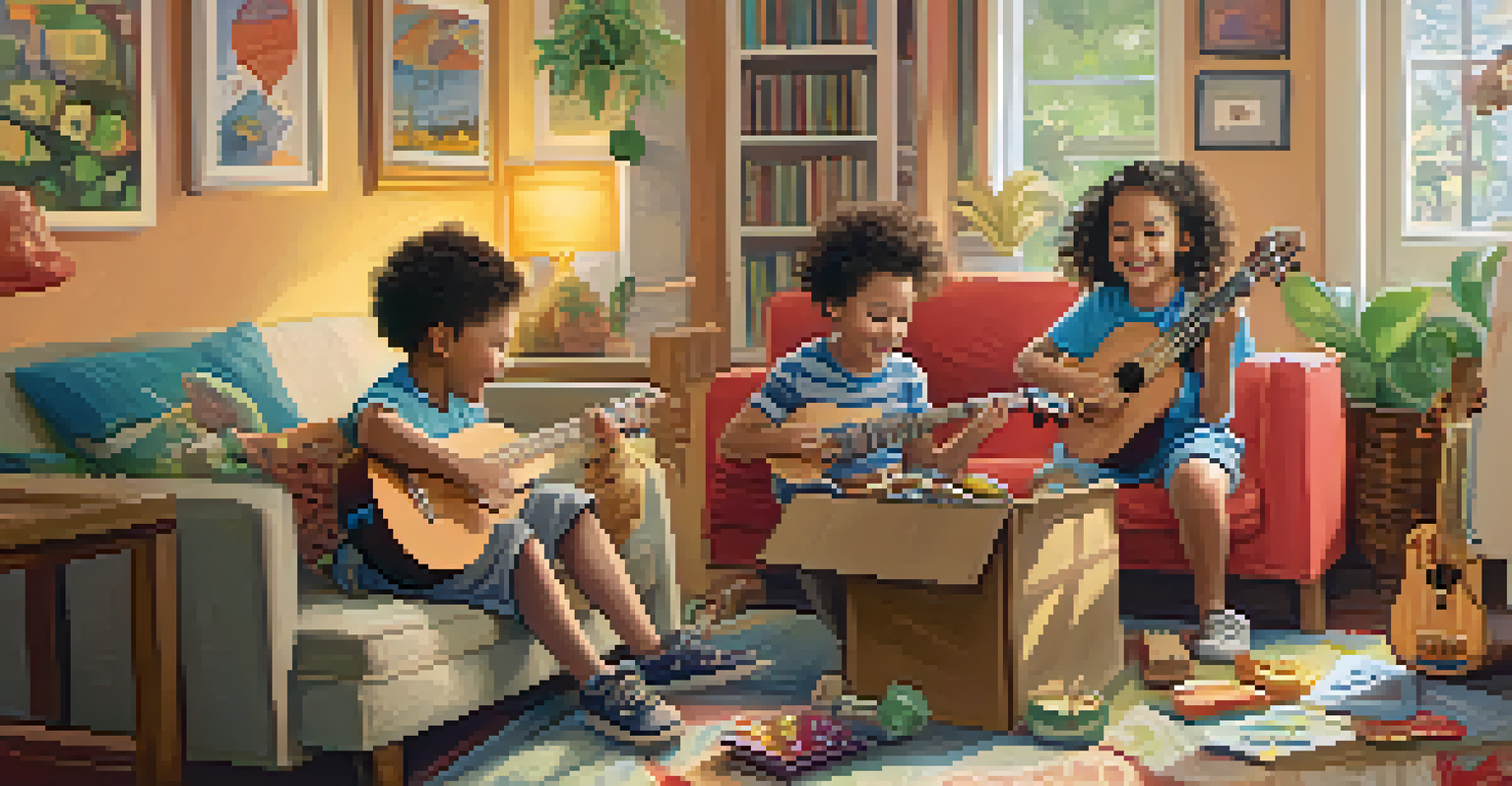Engaging Activities to Teach Ukulele to Young Learners

Start with Simple Chord Shapes for Easy Learning
When teaching young learners, starting with simple chord shapes can make the process enjoyable. For instance, focusing on just two or three easy chords, like C, G, and F, allows children to quickly play songs they recognize. This immediate sense of accomplishment can boost their confidence and keep them motivated to learn more.
Music can change the world because it can change people.
To make it even more engaging, consider using colorful chord charts or stickers on the ukulele. Associating colors with the chords can help younger children remember them better. Creating a visual connection is not only fun but also enhances their learning experience.
Encourage kids to play along with their favorite songs using these simple chords. By selecting songs they know, like nursery rhymes or pop hits, you can create a lively atmosphere that makes practice feel less like a chore and more like a fun activity.
Incorporate Games to Spark Interest
Games are a fantastic way to keep young learners engaged while teaching them ukulele. For example, you can create a 'chord scavenger hunt' where kids must find and play a series of chords hidden around the room. This interactive approach turns learning into an adventure, making it much more appealing.

Another fun game is 'musical chairs' with a twist; instead of chairs, use ukuleles. When the music stops, each child must play a chord or a short melody. This not only reinforces their learning but also promotes listening skills and teamwork among peers.
Start with Simple Chord Shapes
Beginning with easy chords like C, G, and F helps young learners quickly feel accomplished and motivated.
By incorporating these games into your lessons, you create a relaxed and enjoyable environment. This approach helps alleviate any performance anxiety and encourages kids to express themselves musically without fear of making mistakes.
Utilize Popular Songs to Maintain Enthusiasm
Young learners are more likely to stay engaged when they can play songs they love. Choosing popular, age-appropriate songs that are easy to play on the ukulele can help maintain their enthusiasm for learning. Think of songs from popular children's movies or current hits that they sing along to frequently.
Children are not things to be molded, but are people to be unfolded.
You can create a list of these songs and introduce them gradually, ensuring that they align with the chords the students are learning. This not only keeps the lessons fresh but also allows students to feel a sense of ownership over their learning as they play music they enjoy.
Additionally, consider having a mini-concert where kids can showcase the songs they've learned. This event can be a great confidence booster and an opportunity for them to share their progress with family and friends, making the learning experience even more rewarding.
Encourage Group Learning for Social Interaction
Learning the ukulele in a group setting can provide young learners with a sense of community. Group lessons encourage collaboration and social interaction, which can be especially beneficial for children. They can learn from one another, share tips, and even form friendships over their shared interest in music.
Consider organizing group activities where learners can play together, such as strumming along to a song or participating in a ukulele circle. This not only reinforces their skills but also creates a fun and supportive environment that celebrates their collective progress.
Incorporate Games for Engagement
Using games like 'chord scavenger hunts' makes learning ukulele fun and interactive, fostering a positive environment.
Moreover, group learning can introduce an element of healthy competition. Friendly challenges, like who can play a particular song the fastest or with the most creativity, can motivate learners to practice more and improve their skills while building camaraderie.
Integrate Movement to Make Lessons Dynamic
Incorporating movement into ukulele lessons can keep young learners active and engaged. For example, you can have them stand up and strum along while singing, or even incorporate simple dance moves that correspond to the rhythm of the song. This physical activity breaks the monotony and helps reinforce their understanding of timing and rhythm.
Another fun idea is to use rhythm clapping before introducing a song. By establishing the beat through clapping, children can better grasp the musical structure before they even pick up their ukuleles. This approach makes the learning process more dynamic and enjoyable.
By combining music with movement, you cater to various learning styles and keep lessons exciting. This not only enhances their musicality but also ensures that they associate playing the ukulele with fun and enjoyment.
Use Visual Aids to Enhance Understanding
Visual aids can play a crucial role in helping young learners understand the ukulele better. Consider using diagrams, videos, or even animated tutorials that illustrate finger placements and strumming patterns. These resources can provide clarity and make complex concepts easier to grasp.
You might also create flashcards that display different chords or song lyrics. These can be used for quick reference during lessons and help reinforce memory retention. Kids often respond well to visual stimuli, making it easier for them to remember what they've learned.
Encourage Creativity through Songwriting
Promoting songwriting allows children to express themselves while deepening their understanding of music.
In addition, using apps that showcase interactive ukulele lessons can be an exciting way to supplement traditional teaching methods. Technology can make learning feel modern and accessible, catering to the interests of today's tech-savvy kids.
Foster Creativity with Songwriting Activities
Encouraging young learners to write their own songs can be a powerful way to foster creativity. Once they've grasped some basic chords, challenge them to come up with their own lyrics and melodies. This not only enhances their understanding of music but also allows them to express themselves artistically.
You could start by brainstorming themes or subjects they’re interested in, such as their favorite animals or adventures they've had. Providing a fun framework, like a 'fill in the blank' song template, can help them get started without feeling overwhelmed.

Collaborative songwriting sessions can also be a great way to engage kids. By working together to create a group song, they can experience the joy of collaboration and learn the value of teamwork in music creation.